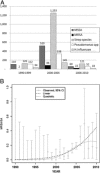Trends in incidence and susceptibility among methicillin-resistant Staphylococcus aureus isolated from intranasal cultures associated with rhinosinusitis
- PMID: 23562203
- PMCID: PMC3901439
- DOI: 10.2500/ajra.2013.27.3858
Trends in incidence and susceptibility among methicillin-resistant Staphylococcus aureus isolated from intranasal cultures associated with rhinosinusitis
Abstract
Background: Reports regarding the incidence and antibiotic susceptibility of methicillin-resistant Staphylococcus aureus (MRSA) in rhinosinusitis (RS) are limited. This study was designed to identify epidemiology and trends of MRSA incidence and antimicrobial resistance in the sinonasal cavities.
Methods: This is a retrospective case series. All intranasal/sinus cultures obtained by otolaryngologists at Stanford over a 20-year period (1990-2010) were retrospectively reviewed by mining the microbiology database. Nested searches were then made for all S. aureus and MRSA cultures. Patterns of incidence and changes in antibiotic susceptibilities were tabulated and statistical analysis was performed.
Results: Our search retrieved 10,387 positive intranasal culture samples, with S. aureus found in 800 (7.7%), and MRSA comprising 110 (1.06%) of this subset. Between the years of 1990 and 1999, only 2/112 (1.7%) of S. aureus-positive nasal cultures were positive for MRSA, with a sharp rise in incidence to 86/606 (14.2%) from 2000 to 2005, and to 22/82, 26.8% from 2006 to 2010. On a percent basis, using logistic regression modeling, this represents a statistically significant increasing trend (p < 0.0001) for MRSA sinusitis. However, over the 20-year interval studied, the patterns of antibiotic resistance among MRSA remained unaltered, especially with regard to trimethoprim-sulfamethoxazole and vancomycin.
Conclusion: S. aureus and MRSA isolates from intranasal cultures, which were essentially absent before the year 2000, became significantly more common earlier this decade. These data show the increased role of MRSA in sinusitis. MRSA antibiotic susceptibilities have remained, however, largely stable during this time period.
Conflict of interest statement
The authors have no conflicts of interest to declare pertaining to this article
Figures

Similar articles
-
Methicillin-resistant Staphylococcus aureus infections in acute rhinosinusitis.Laryngoscope. 2006 Feb;116(2):288-91. doi: 10.1097/01.mlg.0000197316.36698.c4. Laryngoscope. 2006. PMID: 16467721
-
Assessment of trends in antimicrobial resistance in chronic rhinosinusitis.Ann Otol Rhinol Laryngol. 2008 Jun;117(6):448-52. doi: 10.1177/000348940811700608. Ann Otol Rhinol Laryngol. 2008. PMID: 18646442
-
Treatment of chronic rhinosinusitis exacerbations due to methicillin-resistant Staphylococcus aureus with mupirocin irrigations.Am J Otolaryngol. 2006 May-Jun;27(3):161-5. doi: 10.1016/j.amjoto.2005.09.006. Am J Otolaryngol. 2006. PMID: 16647979
-
Sinonasal methicillin-resistant Staphylococcus aureus: updates on treatment.Curr Opin Otolaryngol Head Neck Surg. 2017 Feb;25(1):19-23. doi: 10.1097/MOO.0000000000000324. Curr Opin Otolaryngol Head Neck Surg. 2017. PMID: 27841769 Review.
-
Current issues in the management of sinonasal methicillin-resistant Staphylococcus aureus.Curr Opin Otolaryngol Head Neck Surg. 2009 Feb;17(1):2-5. doi: 10.1097/MOO.0b013e32831b9c97. Curr Opin Otolaryngol Head Neck Surg. 2009. PMID: 19225299 Review.
Cited by
-
Taste receptors in innate immunity.Cell Mol Life Sci. 2015 Jan;72(2):217-36. doi: 10.1007/s00018-014-1736-7. Epub 2014 Oct 17. Cell Mol Life Sci. 2015. PMID: 25323130 Free PMC article. Review.
-
Bacterial d-amino acids suppress sinonasal innate immunity through sweet taste receptors in solitary chemosensory cells.Sci Signal. 2017 Sep 5;10(495):eaam7703. doi: 10.1126/scisignal.aam7703. Sci Signal. 2017. PMID: 28874606 Free PMC article.
-
Calculated parenteral initial treatment of bacterial infections: Infections in the ear, nose, throat and mouth and jaw area.GMS Infect Dis. 2020 Mar 26;8:Doc14. doi: 10.3205/id000058. eCollection 2020. GMS Infect Dis. 2020. PMID: 32373439 Free PMC article.
-
Staphylococcus aureus triggers nitric oxide production in human upper airway epithelium.Int Forum Allergy Rhinol. 2015 Sep;5(9):808-13. doi: 10.1002/alr.21568. Epub 2015 Jun 22. Int Forum Allergy Rhinol. 2015. PMID: 26097237 Free PMC article.
-
Epidemiology of chronic rhinosinusitis, selected risk factors, comorbidities, and economic burden.GMS Curr Top Otorhinolaryngol Head Neck Surg. 2015 Dec 22;14:Doc11. doi: 10.3205/cto000126. eCollection 2015. GMS Curr Top Otorhinolaryngol Head Neck Surg. 2015. PMID: 26770285 Free PMC article. Review.
References
-
- Herold BC, Immergluck LC, Maranan MC, et al. Community-acquired methicillin-resistant Staphylococcus aureus in children with no identified predisposing risk. JAMA 279:593–598, 1998. - PubMed
-
- Benner EJ, Kayser FH. Growing clinical significance of methcillin-resistant Staphylococcus aureus. Lancet 2:741–744, 1968. - PubMed
-
- Barrett FF, McGehee RF, Jr, Finland M. Methicillin-resistant Staphylococcus aureus at Boston City Hospital. Bacteriologic and epidemiologic observations. N Engl J Med 279:441–448, 1968. - PubMed
-
- Boyce JM. Increasing prevalence of methicillin-resistant Staphylococcus aureus in the United States. Infect Control Hosp Epidemiol 11:639–642, 1990. - PubMed
MeSH terms
Substances
LinkOut - more resources
Full Text Sources
Other Literature Sources
Medical

